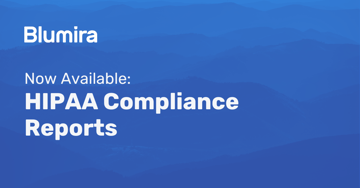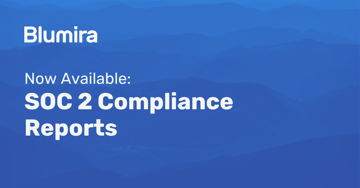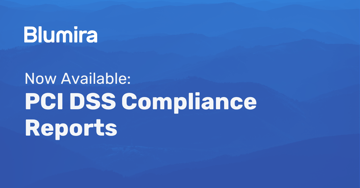NIST SP 800-53 Cybersecurity Framework Compliance
With the help of the Blumira SIEM security platform and Blumira Agent for endpoint visibility, your organization can easily meet and exceed NIST 800-53 compliance requirements, including Audit and Accountability controls.
NIST 800-53, a part of the broader NIST Cybersecurity Framework, applies to all federal institutions and their information systems as well as organizations handling sensitive government data.
Adhering to NIST Special Publication 800-53, if the above holds true for your organization, NIST 800-53 is critical for securing your IT infrastructure, ensuring compliance, and mitigating cybersecurity risks.
Blumira can help. We offer a simple, efficient, and cost-effective approach to achieving and maintaining compliance under NIST cybersecurity framework 800-53. Our solutions automate security monitoring, threat detection, and response to enhance your organization’s security posture and decrease operational burdens for IT and security teams.
What NIST 800-53 Compliance Is and Why It Matters
NIST Special Publication 800-53 (AKA NIST SP 800 53) outlines an organized framework for managing cybersecurity risks across governmental entities and the organizations that do business with them.
Compliance is important for these organizations because it ensures:
- Enhanced security against cyber threats
- Regulatory alignment with government standards
- Proactive risk management to protect sensitive data
- Operational resilience through structured security controls
But achieving and maintaining compliance with NIST publication 800 53 standards is a complex endeavor.
That’s where Blumira’s security solutions are helpful. We offer deep expertise about each individual NIST 800 53 protocol and our solutions are designed to help you meet them all.
An In-Depth Overview of Important NIST 800-53 Security Controls
Below, you’ll find key insights on the most important NIST 800 53 controls for audit and accountability purposes.
Underneath certain specific controls, you’ll also find information about how Blumira makes it easier to achieve compliance.
NIST Publication 800 53: Audit & Accountability Requirements (AU Controls)
-
AU-1 – AUDIT AND ACCOUNTABILITY POLICY AND PROCEDURES
- Develops, documents, and disseminates to [Assignment: organization-defined personnel or roles]:
- An audit and accountability policy that addresses purpose, scope, roles, responsibilities, management commitment, coordination among organizational entities, and compliance
- Procedures to facilitate the implementation of the audit and accountability policy and associated audit and accountability controls;
- Reviews and updates the current:
- Audit and accountability policy [Assignment: organization-defined frequency];
- Audit and accountability procedures [Assignment: organization-defined frequency]
-
AU-2 – AUDIT EVENTS
The organization:
- Determines that the information system is capable of auditing the following events:
- [Assignment: organization-defined auditable events];
- Coordinates the security audit function with other organizational entities requiring audit related information to enhance mutual support and to help guide the selection of auditable events;
- Provides a rationale for why the auditable events are deemed to be adequate to support after the-fact investigations of security incidents
- Determines that the following events are to be audited within the information system:
- [Assignment: organization-defined audited events (the subset of the auditable events defined in AU-2 a.) along with the frequency of (or situation requiring) auditing for each identified event].
- Determines that the information system is capable of auditing the following events:
-
AU-3 – CONTENT OF AUDIT RECORDS
The information system generates audit records containing information that establishes what type of event occurred, when the event occurred, where the event occurred, the source of the event, the outcome of the event, and the identity of any individuals or subjects associated with the event.
-
AU-4 – AUDIT STORAGE CAPACITY
The organization allocates audit record storage capacity in accordance with [Assignment: organization-defined audit record storage requirements].
- Develops, documents, and disseminates to [Assignment: organization-defined personnel or roles]:
- An audit and accountability policy that addresses purpose, scope, roles, responsibilities, management commitment, coordination among organizational entities, and compliance
- Procedures to facilitate the implementation of the audit and accountability policy and associated audit and accountability controls;
- Reviews and updates the current:
- Audit and accountability policy [Assignment: organization-defined frequency];
- Audit and accountability procedures [Assignment: organization-defined frequency]
The organization:
- Determines that the information system is capable of auditing the following events:
- [Assignment: organization-defined auditable events];
- Coordinates the security audit function with other organizational entities requiring audit related information to enhance mutual support and to help guide the selection of auditable events;
- Provides a rationale for why the auditable events are deemed to be adequate to support after the-fact investigations of security incidents
- Determines that the following events are to be audited within the information system:
- [Assignment: organization-defined audited events (the subset of the auditable events defined in AU-2 a.) along with the frequency of (or situation requiring) auditing for each identified event].
The information system generates audit records containing information that establishes what type of event occurred, when the event occurred, where the event occurred, the source of the event, the outcome of the event, and the identity of any individuals or subjects associated with the event.
The organization allocates audit record storage capacity in accordance with [Assignment: organization-defined audit record storage requirements].
-
AU-5 – RESPONSE TO AUDIT PROCESSING FAILURES
The information system:
- Alerts [Assignment: organization-defined personnel or roles] in the event of an audit processing failure;
- Takes the following additional actions:
- [Assignment: organization-defined actions to be taken (e.g., shut down information system, overwrite oldest audit records, stop generating audit records)].
-
AU-6 – AUDIT REVIEW, ANALYSIS, AND REPORTING
The organization:
- Reviews and analyzes information system audit records [Assignment: organization-defined frequency] for indications of [Assignment: organization-defined inappropriate or unusual activity];
- Reports findings to [Assignment: organization-defined personnel or roles]
-
AU-7 – AUDIT REDUCTION AND REPORT GENERATION
The information system provides an audit reduction and report generation capability that:
- Supports on-demand audit review, analysis, and reporting requirements and after-the-fact investigations of security incidents;
- Does not alter the original content or time ordering of audit records.
-
AU-8 – TIME STAMPS
The information system:
- Uses internal system clocks to generate timestamps for audit records;
- Records timestamps for audit records that can be mapped to Coordinated Universal Time (UTC) or Greenwich Mean Time (GMT) and meets [Assignment: organization-defined granularity of time measurement].
The information system:
- Alerts [Assignment: organization-defined personnel or roles] in the event of an audit processing failure;
- Takes the following additional actions:
- [Assignment: organization-defined actions to be taken (e.g., shut down information system, overwrite oldest audit records, stop generating audit records)].
The organization:
- Reviews and analyzes information system audit records [Assignment: organization-defined frequency] for indications of [Assignment: organization-defined inappropriate or unusual activity];
- Reports findings to [Assignment: organization-defined personnel or roles]
The information system provides an audit reduction and report generation capability that:
- Supports on-demand audit review, analysis, and reporting requirements and after-the-fact investigations of security incidents;
- Does not alter the original content or time ordering of audit records.
The information system:
- Uses internal system clocks to generate timestamps for audit records;
- Records timestamps for audit records that can be mapped to Coordinated Universal Time (UTC) or Greenwich Mean Time (GMT) and meets [Assignment: organization-defined granularity of time measurement].
-
AU-9 – PROTECTION OF AUDIT INFORMATION
The information system protects audit information and audit tools from unauthorized access, modification, and deletion.
-
AU-10 – NON-REPUDIATION
The information system protects against an individual (or process acting on behalf of an individual) falsely denying having performed [Assignment: organization-defined actions to be covered by non-repudiation].
-
AU-11 – AUDIT RECORD RETENTION
The organization retains audit records for [Assignment: organization-defined time period consistent with records retention policy] to provide support for after-the-fact investigations of security incidents and to meet regulatory and organizational information retention requirements.
-
AU-12 – AUDIT GENERATION
The information system:
- Provides audit record generation capability for the auditable events defined in AU-2 a. at [Assignment: organization-defined information system components];
- Allows [Assignment: organization-defined personnel or roles] to select which auditable events are to be audited by specific components of the information system;
- Generates audit records for the events defined in AU-2 d. with the content defined in AU-3
The information system protects audit information and audit tools from unauthorized access, modification, and deletion.
The information system protects against an individual (or process acting on behalf of an individual) falsely denying having performed [Assignment: organization-defined actions to be covered by non-repudiation].
The organization retains audit records for [Assignment: organization-defined time period consistent with records retention policy] to provide support for after-the-fact investigations of security incidents and to meet regulatory and organizational information retention requirements.
The information system:
- Provides audit record generation capability for the auditable events defined in AU-2 a. at [Assignment: organization-defined information system components];
- Allows [Assignment: organization-defined personnel or roles] to select which auditable events are to be audited by specific components of the information system;
- Generates audit records for the events defined in AU-2 d. with the content defined in AU-3
-
AU-13 – MONITORING FOR INFORMATION DISCLOSURE
The organization monitors [Assignment: organization-defined open source information and/or information sites] [Assignment: organization-defined frequency] for evidence of unauthorized disclosure of organizational information.
-
AU-14 – SESSION AUDIT
The information system provides the capability for authorized users to select a user session to capture/record or view/hear.
-
AU-15 – ALTERNATE AUDIT CAPABILITY
The organization provides an alternate audit capability in the event of a failure in primary audit capability that provides [Assignment: organization-defined alternate audit functionality].
-
AU-16 – CROSS-ORGANIZATIONAL AUDITING
The organization employs [Assignment: organization-defined methods] for coordinating [Assignment: organization-defined audit information] among external organizations when audit information is transmitted across organizational boundaries.
The organization monitors [Assignment: organization-defined open source information and/or information sites] [Assignment: organization-defined frequency] for evidence of unauthorized disclosure of organizational information.
The information system provides the capability for authorized users to select a user session to capture/record or view/hear.
The organization provides an alternate audit capability in the event of a failure in primary audit capability that provides [Assignment: organization-defined alternate audit functionality].
The organization employs [Assignment: organization-defined methods] for coordinating [Assignment: organization-defined audit information] among external organizations when audit information is transmitted across organizational boundaries.
NIST Compliance: System and Communications Protection & Incident Response Requirements
-
System and communications protection
SC-3 – Security Function Isolation
Blumira Agent identifies anomalous and threat-like behavior associated with endpoints, and sends alerts to an organization. Blumira Agent’s remediation capabilities enable organizations to isolate the endpoint from the rest of their network to contain the threat and protect their systems from a compromised endpoint.
-
System monitoring: S1-4
S1-4(4) – Inbound and Outbound Communications Traffic
S1-4(5) – System-generated Alerts
S1-4(7) – Automated Response to Suspicious Events
S1-4(23) – Host-based Devices
Blumira Agent monitors Windows endpoints (hosts) for attacks and indicators of potential attacks, including unauthorized access.
Blumira analyzes activity (including inbound and outbound communications traffic) to detect events, anomalies, and unauthorized activity, sending alert notifications to organizations about the threat finding with automated instructions on how to respond, or actions to take upon detection.
Blumira Agent enables organizations to respond to suspicious events by isolating hosts to cut off network access and prevent lateral movement.
-
Incident handling: IR-4
IR-4(4) – Information Correlation
IR-4(7) – Insider Threats
IR-4(13) – Behavior Analysis
IR-4(14) – Security Operations Center
Blumira detects, analyzes and helps guide organizations through response to security incidents.
Blumira Agent provides a host isolation capability that enables organizations to quickly contain a compromised endpoint, investigate an incident with access to historical log retention, and aid in guided response with a SecOps team available 24/7 for critical priority issues.
Blumira automates the functionality of a security operations center (SOC) by detecting, analyzing and helping organizations respond to incidents in a timely manner, at scale through its platform.
The Blumira SIEM platform correlates incident information collected from different sources of telemetry across an organization’s IT environment to provide match stacked evidence (alert stacking), helping by gathering relevant data in the event of an investigation. It also provides the ability to search event logs and generate security reports to help with forensics.
Blumira security engineers manage detection rules built into the platform that automatically analyze and detect events related to possible insider threats, as well as help with the analysis of anomalous or suspected adversarial behavior.
SC-3 – Security Function Isolation
Blumira Agent identifies anomalous and threat-like behavior associated with endpoints, and sends alerts to an organization. Blumira Agent’s remediation capabilities enable organizations to isolate the endpoint from the rest of their network to contain the threat and protect their systems from a compromised endpoint.
S1-4(4) – Inbound and Outbound Communications Traffic
S1-4(5) – System-generated Alerts
S1-4(7) – Automated Response to Suspicious Events
S1-4(23) – Host-based Devices
Blumira Agent monitors Windows endpoints (hosts) for attacks and indicators of potential attacks, including unauthorized access.
Blumira analyzes activity (including inbound and outbound communications traffic) to detect events, anomalies, and unauthorized activity, sending alert notifications to organizations about the threat finding with automated instructions on how to respond, or actions to take upon detection.
Blumira Agent enables organizations to respond to suspicious events by isolating hosts to cut off network access and prevent lateral movement.
IR-4(4) – Information Correlation
IR-4(7) – Insider Threats
IR-4(13) – Behavior Analysis
IR-4(14) – Security Operations Center
Blumira detects, analyzes and helps guide organizations through response to security incidents.
Blumira Agent provides a host isolation capability that enables organizations to quickly contain a compromised endpoint, investigate an incident with access to historical log retention, and aid in guided response with a SecOps team available 24/7 for critical priority issues.
Blumira automates the functionality of a security operations center (SOC) by detecting, analyzing and helping organizations respond to incidents in a timely manner, at scale through its platform.
The Blumira SIEM platform correlates incident information collected from different sources of telemetry across an organization’s IT environment to provide match stacked evidence (alert stacking), helping by gathering relevant data in the event of an investigation. It also provides the ability to search event logs and generate security reports to help with forensics.
Blumira security engineers manage detection rules built into the platform that automatically analyze and detect events related to possible insider threats, as well as help with the analysis of anomalous or suspected adversarial behavior.
Additional Compliance Resources
View more
Now Available: HIPAA Compliance Reports
Read More
Now Available: SOC 2 Compliance Reports
Read More
Now Available: PCI DSS Compliance Reports
Read MoreGet Started for Free
Experience the Blumira Free SIEM, with automated detection and response and compliance reports for 3 cloud connectors.